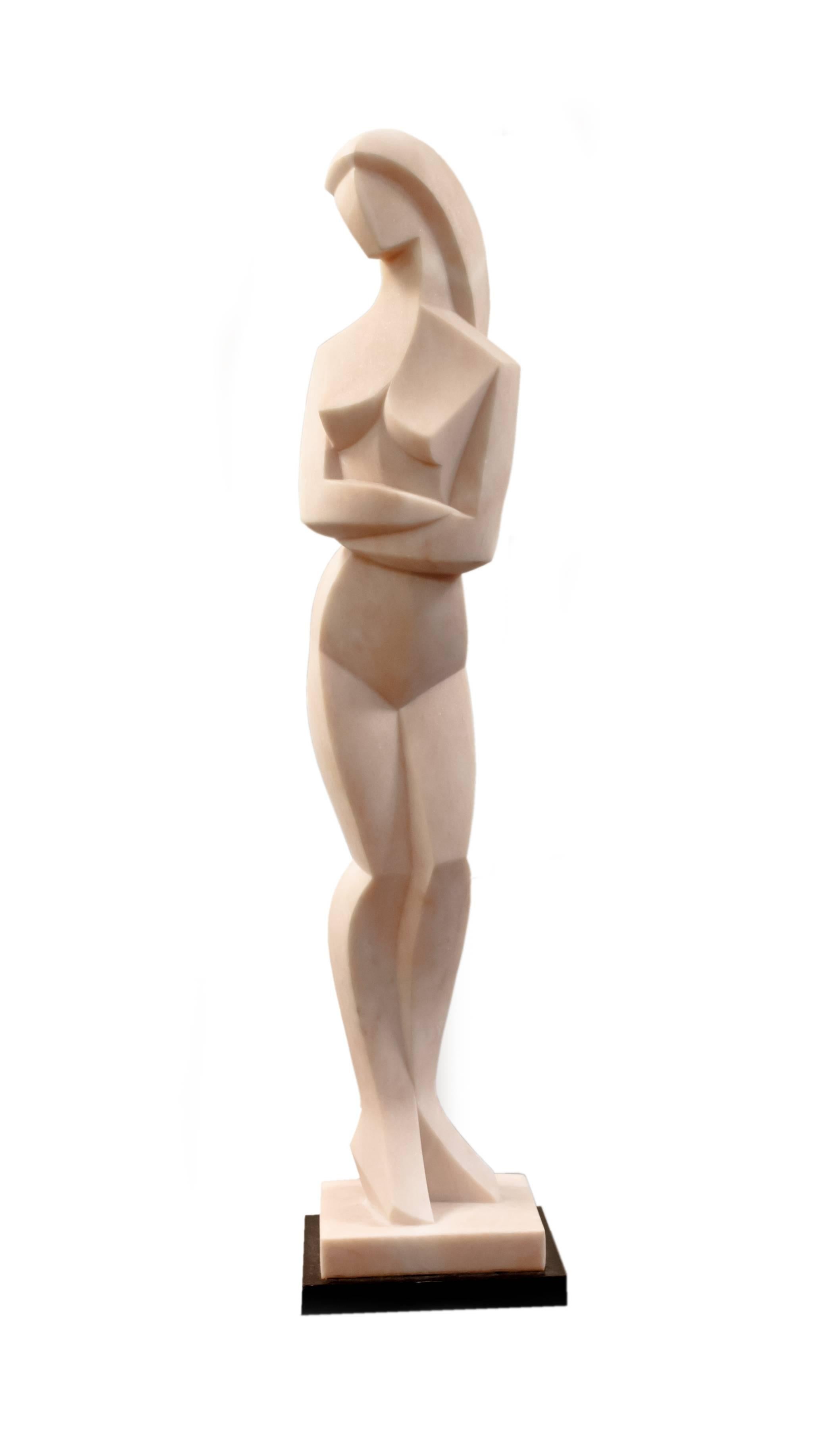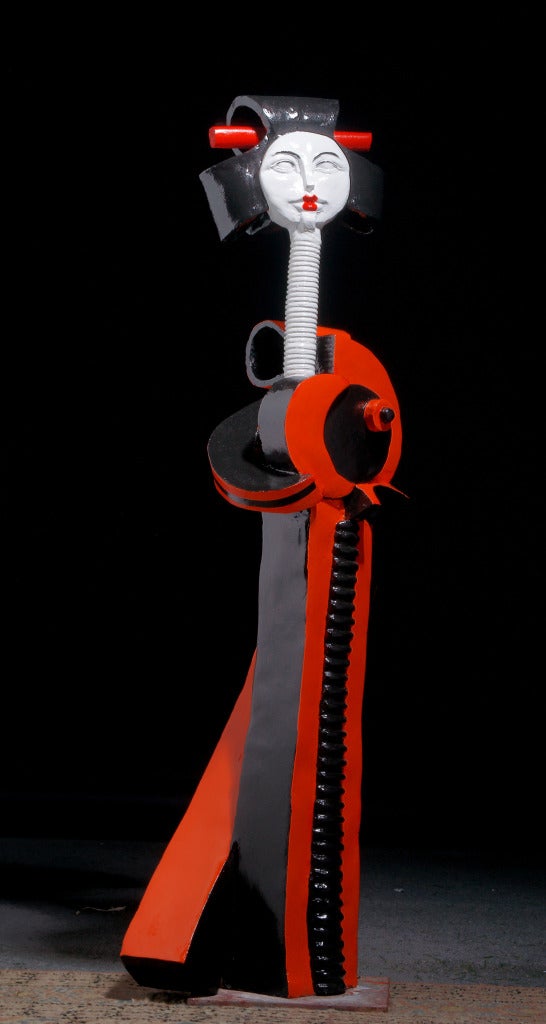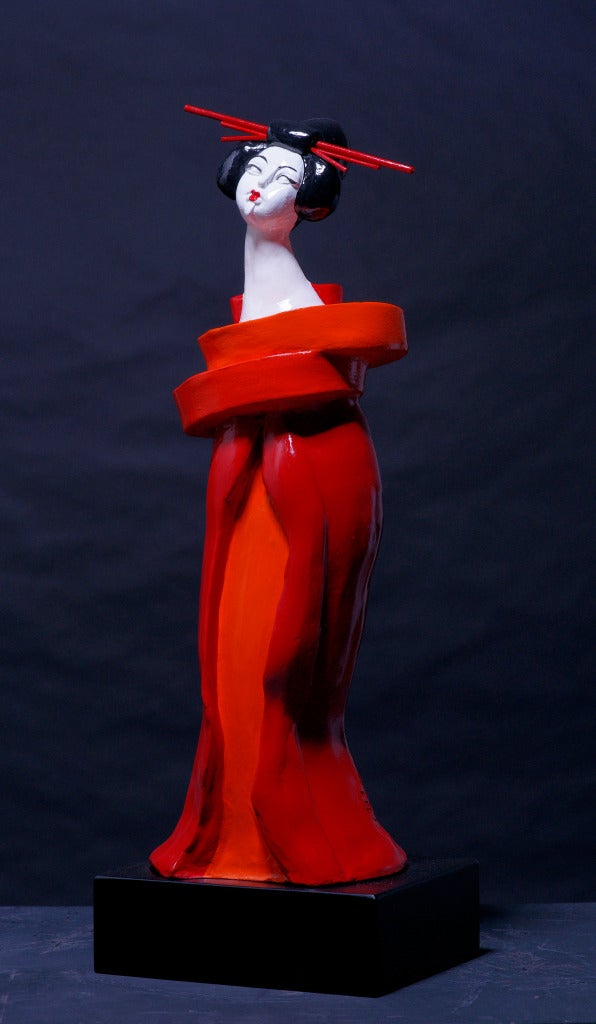Items Similar to Embrasing Couple
Want more images or videos?
Request additional images or videos from the seller
1 of 5
Lorrie GouletEmbrasing Couple1980
1980
About the Item
LORRIE GOULET
"EMBRACING COUPLE"
MARBLE, SIGNED
AMERICAN, C.1980
15 X 5 X 12 INCHES
Lorrie Goulet
Born 1925
Biography from David Findlay Jr. Gallery
"Geometry and Flesh: The Sculpture and Vision of Lorrie Goulet"
Taken from Sculpture Review Magazine
Volume XLII, No. 4
By Dena Merriam
It is rare to find an artist who can with eloquence articulate the source, inspiration and impulses that feed her or his art form. Creation, being an intuitive process, bypasses the verbal—and often the conceptual—circuitry. Artists create, and it is up to others to fathom their works. Highly gifted stone and wood carver Lorrie Goulet has taken it upon herself to explore what it is about a sculpture that causes the work to have an impact on us and evoke an emotional response: in particular, how the harmonies of, say, a Bach composition can be discovered in a piece of stone; and how, without knowing it, we respond to these symphonic forms.
"Sculpting is a conversation without words," says Goulet about the artistic process. "It is a nonverbal communication between the sculptor and the material, and then between the audience and the material. When you listen to a bird, you don't ask what his song is about, but you are moved by its beauty." So it is with sculpture, explains Goulet. Yet there are mathematical equations and relationships in operation in every piece of sculpture that, though we may be unconscious of them, affect the way a work touches us.
"The relationship between music and math is more easily recognized," says Goulet. "I didn't see the mathematical relationships in sculpture until I began quadrating my sculpture through overlays and a grid system."
Some ten years ago, Goulet began overlaying mathematical constructs on sculpture as a teaching aid, to help her students understand the construction of a head. When she began working on the planes of the head, she was amazed at what she found. "You can actually map out the head," says Goulet. You can navigate and put a head together by constructing the angles. That showed me the relationship between art and the natural world."
In sculpture there is an intimate relationship between the seen and the unseen, says Goulet, between the embodied form and the space around it. She points to a line on one of her sculptures, tracing the line out into space beyond the actual stone form. "This line extends outward toward infinity. If you extend this other line, the two will meet our in space and form a triangle—making up the larger construct in which the stone sculpture exists."
Composers may not think about mathematical equations when they compose a work, but intuitively they perceive them, and their success depends on their ability to capture the intricate harmonies underlying the structure of the universe that poets, philosophers and mystics have spoken about through the ages. Similarly, a majority of sculptors don't construct their forms using mathematics, but the most gifted artists intuitively tap into the mathematical laws that govern creation: the actual stone, wood, or bronze piece makes visible a small portion of the lines, triangles, and quadrants that exist within that space. The emotional impact of a work is generated by more than just technical prowess: according to Goulet, there is a correspondence between the power of a sculpture and the degree to which it reflects the universal laws. If we could train our eye to see the whole, not just the visible portion, we would find that great works of sculpture exist within a ratio of harmony and a system and a system of numbers as intricate and interwoven as a Bach fugue. The ratio of harmony is the system of numbers that consistently appears in an artist's work.
Goulet's correlation of math and sculpture came recently in her evolution as an artist. Her early years were occupied with learning to master the medium of stone and with finding her own voice. It is impossible to track her development without mentioning the man with whom she shared forty-three years of her life, the Spanish-born sculptor José de Creeft.
Clearly, de Creeft played a role in shaping the early adult life and work of Lorrie Goulet. But he had less of an influence on her style and aesthetic than one might expect, considering that she met and married the sixty year old sculptor when she was only nineteen. As a young woman coming of age in the shadow of the master carver, Goulet's struggle for independent artistic expression was made all the more difficult, but she was able to muster the will and determination to separate herself artistically from the man she so respected and loved.
When Goulet met de Creeft during her student years at Black Mountain College in North Carolina, she had already set in the direction of art, having worked in the medium of sculpture since the age of eight. The young art student was drawn to the teacher, whom she described as "a great, great sculptor" and "a fountain of creative energy."
"We were two different artists who shared a life and did our own thing," says Goulet. "It was not a competitive relationship. I worked independently and would invite him to my studio once or twice a year. And then it was just to show him my work, not for any criticism or critique."
Over the years Goulet has developed a style and series of themes that are decidedly her own. Relationships, family, love, the earthy undulations of the female form—these are the subjects of Goulet's carvings. Through these themes she strives to convey harmony, serenity, fullness and abundance. Her work is replete with a marvelous feminine energy, where rounded thighs and arms vibrate with a magnetic, yet not quite erotic, rhythm. Whether crouching, reposing, or embracing, her forms are often merging into each other or into the surrounding material, as if to highlight our interconnectedness with each other and the larger universe.
Goulet's forms, portray an exuberance, a joie de vivre. There is a rhythm to their often rocking postures that breathes life into the stone. The amalgam of orbs composing Goulet's forms is, like the earth itself, a landscape of mountains and valleys. Their contours suggest fertility, with its accompanying sense of nourishment and wholeness.
The Kiss achieves a balance in its motion that suggests the ideal harmony which is the goal of the relationship between a man and woman. It is difficult to discern where the woman's form ends and the man's begins, yet in their joining, they remain apart. The two heads jut out from the forms like twin mountain peeks, each maintaining its own strength and dignity.
Goulet's Navajo, although a single figure, portrays a similar sense of wholeness and a combining of forces. In this case, however, it is not the joining of two bodies and souls, it is the quality of self-containment, a gathering of oneself, that is conveyed. It is difficult to determine whether the Native American woman is staring outward or inward, so steady is her gaze.
While Goulet's figures contain great emotive power, they also reflect logical and seasoned relationships—the mathematical properties to which she frequently refers.
"There are numbers connected to my work as well as emotions," says Goulet. The parts of the body are elements in a composition. The invisible structure underlying the form provides its resonance and power.
When Goulet's students ask her what it all means, she tells them to expand their vision to see all points in space where the lines of the figure intersect. Then they will get a sense of the relationship between the seen and unseen.
"This is not a new way of seeing the world," says Goulet with a chuckle. "But it's a way of seeing that hasn't been talked about for a long time. In 600 B.C., Pythagoras said God is numbers and the system of the universe is reflected in everything. In the geometry of the structure can be found an expression of the universal spirit. My work is a combination of flesh and geometry. I am concerned with beauty, order and structure. I am seeking to portray these qualities in my sculpture, as well as the feeling of motion and electricity pulsing throughout life."
- Creator:Lorrie Goulet (1925, American)
- Creation Year:1980
- Dimensions:Height: 15 in (38.1 cm)Width: 5 in (12.7 cm)Depth: 12 in (30.48 cm)
- Medium:
- Movement & Style:
- Period:
- Condition:
- Gallery Location:Los Angeles, CA
- Reference Number:1stDibs: LU392601981
Lorrie Goulet
null
About the Seller
5.0
Vetted Seller
These experienced sellers undergo a comprehensive evaluation by our team of in-house experts.
Established in 1972
1stDibs seller since 2011
384 sales on 1stDibs
Typical response time: <1 hour
- ShippingRetrieving quote...Ships From: Edgewater, NJ
- Return PolicyThis item cannot be returned.
More From This SellerView All
- The OathLocated in Los Angeles, CAPascal "Bugs" Jarrion was born in Perpignan, France, a region known for its Catalan culture and an area that has influenced many artists before him including Picasso, Van Gogh and Ma...Category
2010s Cubist Figurative Sculptures
MaterialsBronze
- GuitaristLocated in Los Angeles, CAULISES JIMENEZ "GUITARIST" WOOD, SIGNED COSTA RICA, C.2005 40 INCHES Ulises Jiménez Obregón was born in La Mansion de Nicoya, Costa Rica, in November 1953. He studied Pl...Category
Early 2000s Cubist Figurative Sculptures
MaterialsWood
- DestinyLocated in Los Angeles, CAUnique, original patinated ceramic. Pascal Jarrion was born in Perpignan, France, in 1961. It is a region known for its Catalan culture and an area t...Category
2010s Cubist Figurative Sculptures
MaterialsCeramic
- The Grape PickerLocated in Los Angeles, CAPascal Jarrion was born in Perpignan, France, in 1961, a region known for its Catalan culture and an area that has influenced many artists before him, i...Category
21st Century and Contemporary Cubist Figurative Sculptures
MaterialsCeramic
- MusicaBy Ulises Jimenez ObregonLocated in Los Angeles, CAULISES JIMENEZ "MUSICA" METAL, SIGNED COSTA RICA, 2022 30 INCHES Ulises Jiménez Obregón was born in La Mansion de Nicoya, Costa Rica, in November 1953. He studied Plastic Arts at the Autonomous University of Central America. 1992 He attended the drawing and painting workshop of the painter Eduardo Barracosa, and followed courses of painting at the ESEMPI School of Art, with the painter Francisco Alvarado Avella. In addition to making sculptures in wood and stone "nicoya marble", he is also a painter. As a sculptor he has around 300 sculptures cataloged and sold all over the world, with works in Europe, Latin America, North America, Canada and Asia. EXHIBITIONS: From 1984 to 2010, he has participated in more than 50 group exhibitions, among others: National Exhibition of Plastic Arts of the Costa Rican Art Museum. Zentic Art Exhibition at the Old Customs National Museum of Costa Rican Art and Embassy of Japan, September 2010. Painting Contest of the North American Costarican Cultural Center. Drawing Contest of the Costa Rican Social Security Fund. He has participated in the following sculpture exhibitions and symposiums: I Meeting of Pacific Sculptors, held in Canton de Orotina in 2006. International Sculpture Meeting in Punta Arenas 2007. Sculptural Encounter of San Ramón 2008. I Symposium of Guadalupe 2009. IV International Credomatic Sculpture Symposium, Barva de Heredia, February 2009. He was selected for the Second Biennial of Painting and Sculpture of the ICE Group, March 2009. II Symposium of Guadalupe, 2010. Sculptural Exhibition 2010 organized by the Municipal School of Integrated Arts of Santa Ana, (March-April 2010). I International Symposium of Plastic Arts, Tejeda, Gran Canaria...Category
21st Century and Contemporary Cubist Figurative Sculptures
MaterialsMetal
- "BAJISTA"By Ulises Jimenez ObregonLocated in Los Angeles, CAULISES JIMENEZ "BAJISTA" METAL, SIGNED COSTA RICA, 2023 32.25 INCHES Ulises Jiménez Obregón was born in La Mansion de Nicoya, Costa Rica, in November 1953. He studied Plas...Category
2010s Cubist Figurative Sculptures
MaterialsMetal
You May Also Like
- EmergenceBy Robert RussinLocated in West Hollywood, CAIt is with great pleasure that we present the original works of American artist Robert Russin (1914-2007) Robert Russin began his career as a WPA sculptor, and received dozens of...Category
1980s Cubist Figurative Sculptures
MaterialsMarble
- VirginieBy Jim RitchieLocated in New York, NYMedium: Rose marble Signed at base: Ritchie 95 Jim Ritchie (1929-2017) born in Montreal, Canada, is known for his pastel drawings and bronze sculptures. He is stylistically linked with Cubism, Abstract figurative work, and modernism, and the human figure is the subject of much of his work. Ritchie had several exhibitions in Montreal before moving to the small town of Vence in Provence, where he lived and worked for over thirty years. The Adelson Galleries...Category
1990s Cubist Figurative Sculptures
MaterialsMarble
- GouvernanteBy MarikoLocated in Miami, FLMariko’s Gouvernante is an unique contemporary sandstone sculpture painted with red, purple, black and white enamel. The geishas collection of the artist expresses the various faces ...Category
21st Century and Contemporary Cubist Sculptures
MaterialsSandstone, Enamel
- MitsoukoBy MarikoLocated in Miami, FLMariko’s Mitsouko is an unique contemporary sandstone sculpture painted with orange, black and white enamel. The geishas collection of the artist expresses the various faces of the f...Category
21st Century and Contemporary Cubist Sculptures
MaterialsSandstone, Enamel
- SentinelleBy MarikoLocated in Miami, FLMariko’s Sentinelle is an unique contemporary sandstone sculpture painted with orange, red, purple, black and white enamel. The geishas collection of the artist expresses the vario...Category
21st Century and Contemporary Cubist Sculptures
MaterialsSandstone, Enamel
- NagoyaBy MarikoLocated in Miami, FLMariko’s Nagoya is an unique contemporary sandstone sculpture painted with orange, red, black and white enamel. The geishas collection of the artist expresses the various faces of ...Category
21st Century and Contemporary Cubist Sculptures
MaterialsSandstone, Enamel
Recently Viewed
View AllMore Ways To Browse
Couple In Woods
Bronze Couple
Sculpture Black Couple
Cubist Music
Large Stone Head Sculpture
The Kiss Sculpture
Bronze Erotic Art
Orb Sculpture
Marble David Sculpture
Marble Sculpture Of David
Stone Marble Head
Set Of 4 Bronzes Sculptures
Large Bronze Bird Sculptures
Marble Female Head
Bird Woman Sculpture
Kissing Couple
4 Seasons Sculpture
Marble Woman Head






